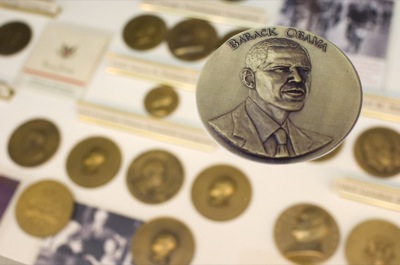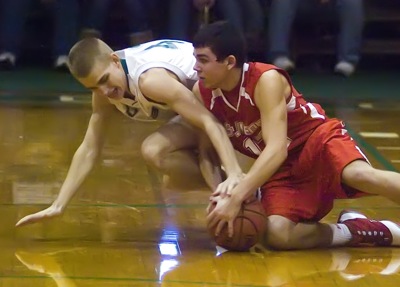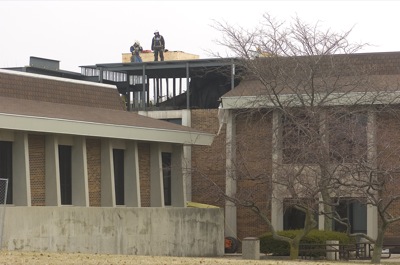Monday, January 12th, 2009
Inaugurating an exhibit for museum in Bremen
Presidential memorabilia ready for public viewing
By Margie Wuebker

Photo by Mark Pummell/The Daily Standard
Annette Thompson, curator for The Bicycle Museum of America in New Bremen, adds a presidential inaugural medal to a new permanent display highlighting the men who have served in the nation's highest office. In addition to cast medals, the display includes elaborate inaugural programs and even dance cards complete with pencils.
NEW BREMEN - If cast medals, dance cards and elaborate programs could talk, The Bicycle Museum of America would be filled with tales of presidential inaugurations.
A new permanent display of inauguration memorabilia has opened at the museum, just as Barack Obama is set to take the oath of office Jan. 20 as the 44th president of the U.S.
"It's fun to have these links to the past," museum coordinator Annette Thompson says. "Each in this case represents history in one form or another."
A custom-built cabinet circa 1895 holds the display representing the private collection of James F. Dicke II and James F. Dicke III. It contains highly detailed medals covering 22 terms from those of Franklin D. Roosevelt to George W. Bush. Thompson believes it is only a matter of time before an official Obama medal joins the fold.
Other memorabilia gives visitors insight into bygone times, such as when ladies in bouffant skirts filled out dance programs with designated partners for waltzes, promenades, quadrilles and polkas. Cording about the wrist assured no woman lost neither the program - roughly the size of a deck of playing cards - nor the tiny accompanying pencil.
Someone took very good care of this souvenir program from Benjamin Harrison's March 1889 inauguration. The same goes for the dance card from William McKinley's 1901 inaugural ball.
"You have to see these souvenirs in order to appreciate them," Thompson says. "Printers used incredible raised lettering not to mention gold leaf and satin ribbon that have withstood the test of time."
The coordinator has put together a loose-leaf binder full of historical information related to the display. She also is planning programs geared toward school children. Such programs are offered in conjunction with Ohio's Academic Content Standards in the areas of social studies, science, mathematics, technology, history and art.
The display will become a permanent addition to the museum, meaning it will be available for viewing long after excitement about the Obama inauguration wanes.
"The display will likely change with new additions from time to time," Thompson says. "This is definitely not something that will be here for six months and then disappear. It represents a wonderful gift from the Dickes - a gift to be enjoyed by everyone from school children to senior citizens."
Medals have been part of presidential history since the first term of George Washington, according to Thompson. He reportedly wore a set of specially made metal buttons inscribed with eagles. Button manufacturers in New York and Connecticut seized the opportunity to issue commemorative sets.
In the book "The Official Inaugural Medals of the Presidents of the United States," author Richard B. Dusterberg noted the issuance of badges and medals evolved from a need to identify thousands of committee members who circulated in train stations, hotels and offices tending to a myriad of details.
Official inaugural medals debuted in 1901 when Ohio native William McKinley took the oath of office for a second term. The "official" designation refers to inaugural medals that are solely the work of private artists whose work is commissioned by the official inaugural committee and officially struck at a specific private mint.
The cast medals have intricate detail. Some include the president as well as the vice president. No two are exactly alike with Thompson pointing out they are customized every four years. That goes for Franklin Roosevelt's four inaugurations that gave birth to a series of medals by world-class sculptors.
"These are pieces that speak to you from the past," Thompson says. "And what a past it has been."
Museum hours are 11 a.m.- 5 p.m. weekdays and 11 a.m.- p.m. Saturdays. Admission charge is $3 for adults, $2 for senior citizens and $1 for children.
Inauguration trivia:
The inauguration of a new president is a time for celebration in the U.S. Amid all the pomp and circumstance, there have been some interesting occurrences:
• George Washington delivered the shortest inaugural speech. It contained 135 words, which took less than two minutes to deliver on March 4, 1793. He is the only president to be inaugurated in two cities - New York and Philadelphia. He reportedly enjoyed a minuet and two square dances before calling it a night.
• William Henry Harrison gave the longest inaugural speech - 8,445 words - in the midst of a March 4, 1841 snowstorm. The 68-year-old president refused to wear a hat or coat while riding a horse to and from the Capitol as well as during the oration that lasted 1 hour and 45 minutes. He ended up catching a cold. Harrison also holds the distinction of having the shortest term, dying from pneumonia a month later, and being the first president to die in office.
• The worst weather undoubtedly occurred the day of William H. Taft's 1909 inauguration. The ceremony took place indoors after a winter storm dropped 10 inches of snow while strong winds toppled trees and telephone poles. Sanitation workers shoveled sand and snow throughout much of the night. It took 6,000 men and 500 wagons to clear 58,000 tons of snow and slush from the parade route.
• Two presidents - John Quincy Adams and Theodore Roosevelt - chose not to include Bibles when taking the oath of office. Richard Nixon used two while Barack Obama plans to lay his hand on the Bible from Abraham Lincoln's inauguration 200 years ago.
• Ulysses S. Grant holds the distinction of having the worst luck in terms of inaugural balls. With the temperature reaching 16 degrees inside a temporary wooden building constructed for the occasion, champagne turned to slush, oysters froze, violin strings snapped and guests danced in coats and hats. Planners brought in 100 canaries to add a whimsical touch but they forgot to preheat the hall. The birds perished before the night ended.
• There was no inaugural ball or parade in 1945 when Franklin D. Roosevelt became president of a worn-torn country. Luncheon guests dined on chicken salad, rolls without butter and pound cake.
• Richard Nixon made several faux pas during visits to several inaugural balls. He forgot to introduce his wife Pat at one of the fancy affairs, breaking a tradition as old as the ball itself. Later, he prepared to step into a limousine bound for the next ball when an aide reminded him the First Lady had been left behind. Nixon sent a Secret Service agent to fetch her.
• Noted poet Robert Frost made a special appearance on the platform at John F. Kennedy's inauguration to read a poem he penned for the occasion. However, Frost had difficulty reading the text due to blinding winter sunlight. He eventually gave up and recited a poem he knew by heart.

Photo by Mark Pummell/The Daily Standard
A picture of what the Barack Obama medal will look like rests with other presidential memorabilia at The Bicycle Museum of America in New Bremen. The medal is being cast in preparation for his Jan. 20 inauguration.


